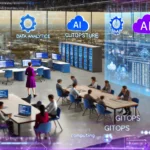Wondering how to apply Computer Vision techniques in real-world scenarios? In a world dominated by visual information, the power of computer vision is unparalleled. This groundbreaking field of artificial intelligence enables machines to interpret and understand the world through images and videos, just like humans do. From self-driving cars navigating busy streets to medical imaging diagnosing illnesses, computer vision has found its way into countless real-world applications.
So, why does computer vision matter so much? The answer lies in its ability to revolutionize industries and improve our daily lives. With the capacity to identify objects, recognize patterns, and make intelligent decisions, computer vision opens a realm of possibilities that seemed like science fiction not long ago.
However, achieving these remarkable feats is not without challenges. As we go deeper into the world of computer vision, we must address issues like data quality, model accuracy, and real-time processing. Nonetheless, by embracing this technology and conquering the hurdles, we unlock a future where computers see and understand the world with human-like clarity.
What are Computer Vision Fundamentals?
Computer vision, a captivating field within artificial intelligence, empowers machines with the ability to perceive and interpret visual information, mirroring the human sense of sight. This section will delve into the foundational aspects of computer vision, shedding light on its scope and key components.
At its core, computer vision involves the development of algorithms and techniques that allow computers to comprehend images and videos. The scope of computer vision spans across numerous industries, including healthcare, automotive, agriculture, retail, and more. From medical image analysis to facial recognition systems, computer vision’s reach knows no bounds.
Key Components: Image Processing, Pattern Recognition, and Machine Learning
Computer vision relies on three crucial components that work in tandem to unlock its potential:
Image Processing: The initial step involves acquiring, enhancing, and analyzing digital images to extract relevant information.
Pattern Recognition: This component enables computers to recognize patterns or specific objects within images, a skill vital for various applications like object identification.
Machine Learning: By training algorithms on vast datasets, machine learning empowers computer vision systems to improve accuracy and make informed decisions.
Common Algorithms: Object Detection, Image Segmentation, and Feature Extraction
Within computer vision, several essential algorithms play pivotal roles in extracting meaningful insights:
Object Detection: This algorithm identifies and localizes objects within images, allowing for precise recognition and classification.
Image Segmentation: It divides an image into meaningful segments, enabling detailed analysis of specific regions or objects.
Feature Extraction: By capturing distinctive features from images, this algorithm aids in pattern recognition and classification tasks.
# First Prepare Data While Learning How to Apply Computer Vision Techniques in Real-World Scenarios
To achieve accurate and reliable results in computer vision applications, meticulous data preparation is paramount. This section will explore the essential steps involved in preparing data for computer vision tasks.
Data Collection Techniques for Real-World Scenarios
Collecting high-quality data is the foundation of successful computer vision projects. Real-world scenarios often present diverse challenges, such as varying lighting conditions, occlusions, and complex backgrounds. Employing multiple data collection techniques, such as using diverse cameras, capturing images from different angles, and incorporating augmented data, ensures the model’s robustness in handling real-world complexities.
The Art of Data Annotation and Labeling
Data annotation and labeling breathe life into raw images, making them meaningful for computer vision algorithms. Accurate and consistent labeling of objects, boundaries, and keypoints is vital for supervised learning, where the model learns from labeled examples. Manual annotation and automated labeling tools, along with crowd-sourcing strategies, are often employed to achieve precise annotations.
Imbalanced Datasets in Computer Vision
Imbalanced datasets, where certain classes have significantly more or fewer instances than others, pose challenges to computer vision models. Biased datasets can lead to skewed predictions, affecting the model’s performance. Addressing this issue involves techniques such as data augmentation, re-sampling, and using specialized loss functions to give equal importance to underrepresented classes.

# Apply Computer Vision Techniques
Object Detection in Real-Time: Tips and Tricks
- Optimize model architectures for faster processing without compromising accuracy.
- Leverage hardware acceleration, such as GPUs and TPUs, to speed up inference.
- Use lightweight models like SSD (Single Shot Multibox Detector) and YOLO (You Only Look Once) for real-time applications.
- Employ transfer learning with pre-trained models to bootstrap your real-time object detection system.
- Implement efficient non-maximum suppression (NMS) techniques to eliminate duplicate detections and improve efficiency.
- Consider multi-scale object detection to handle objects of various sizes effectively.
Image Segmentation for Precise Object Identification
Image segmentation takes computer vision to the next level by precisely identifying object boundaries within an image. Unlike object detection, which only detects objects’ presence, image segmentation performs pixel-level classification, offering a more detailed understanding of visual content. This technique finds applications in various domains, from medical imaging to autonomous vehicles.
Semantic segmentation classifies each pixel into specific categories, effectively creating a pixel-level map of the objects present in the image. On the other hand, instance segmentation takes it a step further, identifying individual instances of objects, even if they belong to the same category.
Extract Meaningful Features for Classification
In the realm of computer vision, feature extraction is a crucial step in classification tasks. Convolutional Neural Networks (CNNs) excel at automatically learning and extracting relevant features from images. These learned features enable CNNs to distinguish between different objects and achieve impressive classification accuracy.
The process of feature extraction involves passing an image through the CNN layers, where the network learns to detect patterns and relevant features. These features are then used to train a classifier that can recognize objects based on the extracted information.
# Evaluate and Improving Computer Vision Models
In the fast-paced world of computer vision, evaluating and enhancing model performance is essential to stay ahead. This section delves into the crucial aspects of evaluating, optimizing, and generalizing computer vision models for real-world success.
Performance Metrics for Computer Vision Models
Accurate evaluation metrics are the compass guiding computer vision model development. While accuracy is vital, it’s not the only metric that matters. Precision, recall, F1-score, and IoU (Intersection over Union) are essential in object detection and segmentation tasks. Mean Average Precision (mAP) is commonly used to assess detection accuracy across multiple object categories. Understanding these metrics helps developers gain deeper insights into model performance and identify areas for improvement.
Techniques for Model Optimization and Generalization
- Learning rate scheduling: Dynamically adjusting the learning rate during training to balance rapid convergence and model stability.
- Weight decay: Introducing a penalty term to the loss function to prevent large weight values, reducing the risk of overfitting.
- Batch normalization: Normalizing activations within each mini-batch, improving training speed and generalization.
- Data augmentation: Introducing variations in the training data through transformations like rotations, flips, and brightness adjustments, enriching the dataset and promoting better generalization.
- Dropout: Randomly deactivating neurons during training to prevent over-reliance on specific features and enhance model robustness.
- L1/L2 regularization: Adding a regularization term to the loss function to encourage sparse weight matrices and prevent overfitting.
- Hyperparameter tuning: Systematically searching for the best combination of hyperparameters, such as learning rate, batch size, and optimizer, to optimize model performance.
- Early stopping: Monitoring the validation loss during training and stopping when it starts to increase, preventing overfitting.
- Transfer learning: Utilizing pre-trained models on large datasets as a starting point and fine-tuning them on specific tasks, reducing training time and data requirements while achieving better performance.
The Role of Transfer Learning in Real-World Scenarios
Transfer learning has revolutionized the computer vision landscape, enabling faster model development and improved performance. Leveraging pre-trained models trained on massive datasets, such as ImageNet, as a starting point allows developers to skip the arduous training process from scratch. Fine-tuning these models on specific tasks requires less data and training time while delivering impressive results.
Transfer learning’s versatility extends to various computer vision applications, from image classification and object detection to semantic segmentation. By adapting pre-trained models to suit specific needs, transfer learning facilitates the rapid deployment of computer vision solutions in real-world scenarios.
# Overcome Challenges in Real-World Computer Vision
While computer vision has made remarkable strides, real-world applications often present a set of unique challenges. This section discusses the hurdles faced in deploying computer vision systems and the strategies to overcome them.
Address Environmental Factors and Lighting Conditions
In the real world, computer vision models encounter diverse environmental conditions, including variations in lighting, weather, and background clutter. To enhance model robustness, developers need to curate diverse and representative datasets that encompass these real-world scenarios. Additionally, augmenting the data with various lighting conditions and weather effects enables the model to adapt better to dynamic environments.
Furthermore, incorporating domain adaptation techniques helps bridge the gap between the training data and the real-world scenarios, reducing the model’s sensitivity to environmental changes.
Dealing with Occlusions and Noisy Data
Objects in the real world are often partially occluded or obscured, presenting challenges for computer vision models. Techniques like data augmentation with occluded samples, employing multi-view training, and using generative adversarial networks (GANs) for data synthesis aid the model in handling occlusions more effectively.
Noise in data, whether due to sensor imperfections or labeling errors, can significantly impact model performance. Applying robust data cleaning methods, using ensemble learning to combine multiple models, and implementing outlier rejection mechanisms help mitigate the impact of noisy data and improve overall accuracy.
Ethics and Privacy Considerations in Computer Vision Applications
As computer vision technology permeates various aspects of our lives, ethical considerations become paramount. Models deployed in surveillance, facial recognition, and other sensitive applications must adhere to strict privacy guidelines. Ensuring transparency in data collection and usage, obtaining informed consent, and providing opt-out mechanisms for individuals are vital steps to maintain ethical standards.
Bias in computer vision models, leading to discriminatory outcomes, is another ethical concern. Developers must strive for fairness and inclusivity by carefully curating diverse datasets and employing bias mitigation techniques during model training.
Moreover, regular audits and evaluations of computer vision systems are necessary to identify potential ethical concerns and ensure compliance with ethical guidelines and regulations.

Real-World Applications of Computer Vision
Enhance Surveillance and Security Systems
Computer vision has revolutionized surveillance and security systems, elevating their capabilities to unprecedented levels. By deploying advanced object detection and tracking algorithms, security cameras can automatically identify and monitor potential threats, such as intruders or suspicious activities. Real-time analysis of video feeds enables swift response to security breaches, enhancing overall safety and reducing response time in critical situations. Moreover, computer vision can be integrated with facial recognition technology, allowing for accurate identification of individuals, bolstering access control measures, and aiding law enforcement agencies in criminal investigations.
Revolutionize Healthcare with Medical Imaging
Computer vision’s impact on healthcare is monumental, particularly in medical imaging. From diagnosing diseases to assisting in surgical procedures, computer vision enhances the accuracy and efficiency of medical diagnosis and treatment. Image segmentation techniques help pinpoint anomalies and tumors in medical scans, providing crucial information for effective treatment planning. Additionally, computer vision systems can analyze vast amounts of medical data to identify patterns and correlations, aiding in early disease detection and personalized patient care.
Advancements in Autonomous Vehicles and Robotics
Object Detection for Collision Avoidance: Computer vision enables autonomous vehicles to detect and identify obstacles, pedestrians, and other vehicles on the road, ensuring safe navigation and collision avoidance.
Lane Detection and Lane Keeping: Advanced computer vision algorithms can accurately detect lane markings and assist autonomous vehicles in staying within their designated lanes, enhancing road safety.
Environmental Perception: Computer vision allows autonomous vehicles to perceive and interpret their surroundings, including traffic signs, signals, and road conditions, facilitating intelligent decision-making.
Robotic Vision for Industrial Automation: Computer vision equips robots with visual perception, enabling them to perform complex tasks such as object recognition, pick-and-place operations, and quality control in manufacturing settings.
Human-Robot Interaction: Computer vision technology facilitates natural and intuitive interactions between humans and robots, enabling robots to understand gestures, facial expressions, and body language for seamless collaboration.
Conclusion
The ever-growing impact of computer vision is undeniable. Its ability to perceive and interpret visual information has revolutionized various industries, from healthcare to autonomous vehicles. Real-world applications of computer vision have elevated surveillance and security systems, transformed medical imaging, and empowered innovation in robotics and automation.
As technology continues to advance, computer vision will play an increasingly vital role in shaping our future. Embracing this transformative technology in your projects opens a world of possibilities, enabling you to create intelligent and efficient solutions that address real-world challenges.
With computer vision as your ally, embrace the future of innovation and unlock the full potential of AI-powered visual intelligence.
For further knowledge, learn how can deep learning models be trained.








